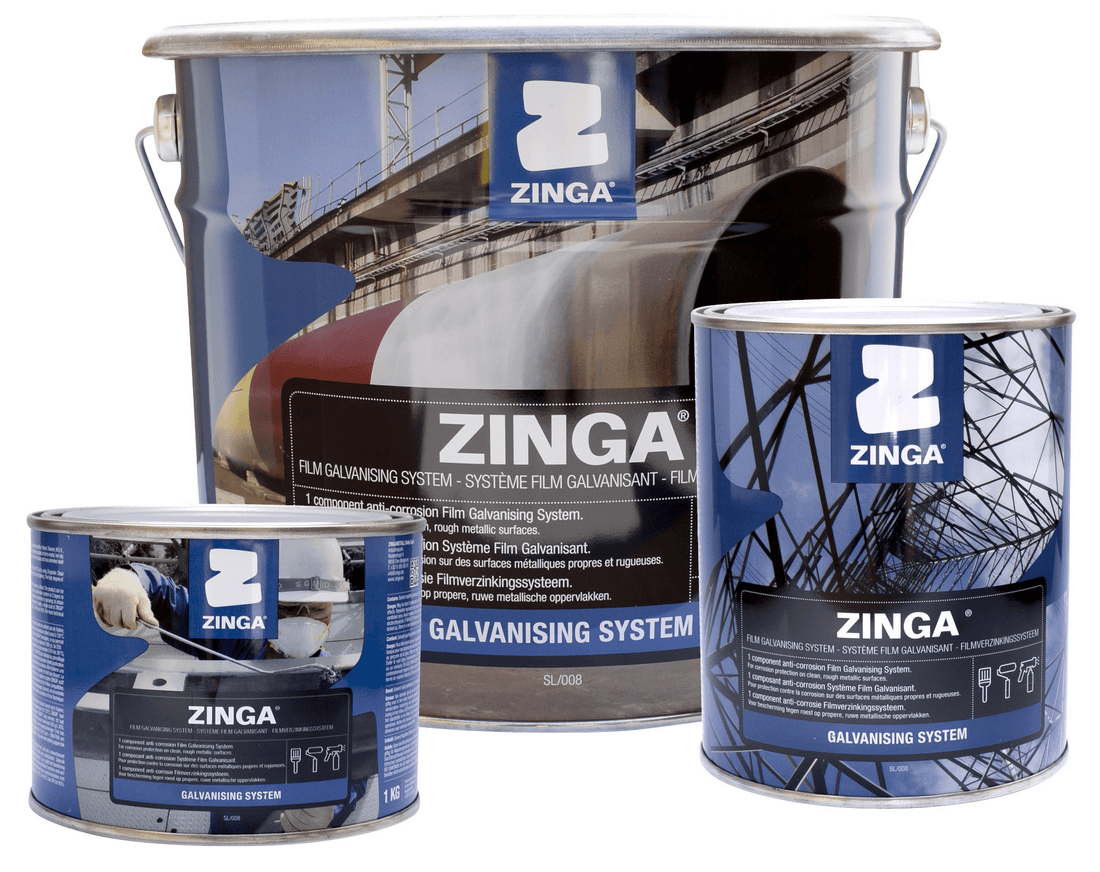(Price Includes VAT)
Zinga
Description
Zinga is a unique form of corrosion protection because it provides both Active and Passive protection in a form that's as easy to apply as a paint...
BUT... Zinga is not a paint!
Zinga is an active zinc performance coating which works in conjunction with the metal beneath where as paints are only passive barriers. Regardless of how thick paints are applied, they remain as barriers. Once they are breached corrosion sets in immediately. Despite this significant difference Zinga is still often mistaken for a paint simply because it's liquid and comes in a tin. But there are other more subtle differences. For example it does not "skin over" in the tin because Zinga has an unlimited pot-life and it doesn't go "tacky" like a paint.
Key Features:
- Can protect as long as hot-dip galvanising
- Can be applied on site
- Can be used to re-coat existing galvanising
- Existing layers of Zinga can be re-coated
- Excellent primer in Duplex system
- Good resistance to mechanical abrasion
- Excellent adhesion
- Extremely flexible
- Can be applied in extreme temperatures
- Weldable to X-ray quality
- Certified to not spread flame or create smoke (BS476 parts 6&7)
- Unlimited shelf-life and unlimited pot-life
Additional Information
It cannot be stressed strongly enough that the key to Zinga's long life is in the thorough preparation of the steel substrate to the correct specification. Please always follow the appropriate Zinga UK specification in conjunction with the relevant Technical Data Sheets. (TDS)
The following information will give a general guide to the coating and its application.
Marine structures
- Remove all crustacean growth using either a UHP water-jet or a high-pressure wash-down
- Dry off
- Blast-clean to Sa2.5 cleanliness
Old or worn galvanising, thermally sprayed zinc (TSZ) or old Zinga
- Steam-clean to remove all contamination from porous surfaces
- Dry off
- Blast-clean as normal
New steel
- Steam-clean or high-pressure wash-down all surfaces
- Allow to dry
- Blast-clean to a cleanliness standard of Sa 2.5
New galvanised steel
- Steam-clean
- Sweep-blast the surface/s at a blast-pressure of 55 psi using a 45o nozzle angle to avoid - Removing any existing zinc thickness.
Cast-iron
- Steam-clean or high-pressure wash-down
- Allow to dry
- Blast-clean to SA2.5 cleanliness
Aluminium alloys
- Solvent clean as per SSPC-SP1 Standard,
- Blast-clean with aluminium-oxide media grade 3
- Vacuum surface/s before paint application
Note 1: The term "high pressure" means a minimum water-pressure of 10,000psi. Any pressures below this level will not totally remove engrained chlorides.
Note 2: The grit used on all structural steelwork must comply with 50µm and 80µm depending on the type of application). The chosen grit should always be able to achieve a blast roughness of 12.5 to 15 microns. It should be noted that UHP Blasting does not create a profile and should therefore never be used as the sole means of surface preparation. UHPAB is an excellent form of blast-cleaning for marine structures as it removes all crustacean growth, scale, engrained chlorides and invisible contaminants.
Once thoroughly mixed, Zinga can be applied by using a normal paintbrush, a short-fibre roller (not for the first coat) or a conventional or airless spray-gun. When applying Zinga by spraying it must only be thinned with Zingasolv, which is available from your nearest distributor. Please read the appropriate Data Sheet.
Zinga can be applied in a wide variety of weather conditions. The application surface temperature range is from -15C to +60C where conditions allow with a maximum humidity of 95% so long as there is 3C minimum between the steel temperature and the dew point. Like all coatings the substrate surface should be free from all types of contamination.
Please seek advice from the Zinga UK Technical Department for extreme application environments.
The broad range of allowable application conditions that Zinga affords means that very few days are lost during projects due to poor weather i.e. the maintenance window is extended. This, combined with Zinga's unlimited pot and shelf life, ensures minimal wastage of either time or materials during a project.
In practice, the quantity of Zinga required to coat a given area is dictated by both the required dry film thickness (DFT) and the depth of the blast-profile.
As a guide to coat 1m2 of steel with a Blast profile of 60micons Rz, at a DFT of 60microns (with no wastage) will require 0.41kg of Zinga.
Or coverage equates to 2.41sqm per 1kg of Zinga.
Once dried, the Zinga film requires exposure to fresh air, carbon dioxide and moisture to become fully cured. The natural porosity of the coating is dramatically reduced as curing takes place, and Zinga continues to harden for several weeks after application.
It is very important to note that before exposure to a saline environment (i.e. submerged in salt water or placed in a salt spray zone) all zinganised surfaces will require saturation with fresh water for a minimum of two hours to properly seal them. If the coating is unlikely to be immediately exposed to a salt atmosphere then exposure to rainwater or heavy overnight condensation for a couple of days will have the same sealing effect. Zinga can also be forced dried using Infrared drying systems.
Approximate Drying Times (45µm DFT) @ 20C:
- Touch dry in 10 minutes
- Dry to handle in 30 minutes (using heavy lifting equipment)
- Dry to overcoat with more Zinga in 60 minutes
- Dried to overcoat with water-based paints in 4 hours
- Dried to overcoat with Alufer N sealer in 4 hours
- Dried to overcoat with 2K PU or acrylic paints in 4 hours
- Cured to overcoat with epoxy in 24 hours
Request Materials Safety Data Sheet (MSDS)
Recommended Thinner

